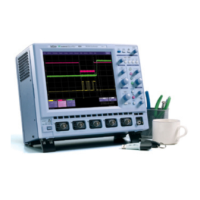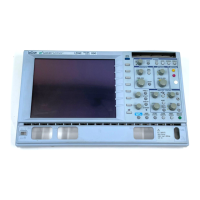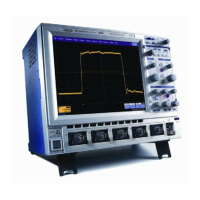422 WM-OM-E Rev I
run the Viterbi detector on the filtered waveform fifteen to twenty times. While the filter training is in
progress, a message is displayed showing the last boost and -3 dB settings and the mean of the
100 worst SAM values at that setting.
The result of training is a close approximation to the best settings for our digital version of a CTAF
on the current acquisition, using the current setup of the FIR. The cleaner the waveform, the better
the approximation will be. The filter should be trained on a signal from a good read, those settings
can be used for all reads in the same zone.
Train Filter should be done with the acquisition stopped (press STOP on the DDA), so that the
same waveform is worked on each time; otherwise the search may be slow to converge. Train
Filter can take a significant amount of time, and it is recommended that it be done on relatively
short waveforms of 50 or 100 kpoints. Once trained, the memory length can be adjusted to the
desired length. To ensure that the group delay is flat, the filter requires at least five samples per bit
cell. This is not a hard limit, but performance will degrade with fewer than five samples per bit cell.
Alternatively, you can adjust the filter settings manually.
-3 dB Frequency
This is the actual -3 dB frequency of the filter. In most implementations of frequency cutoff (fc), the
-3 dB point, if Boost is 0 dB and group delay is 0%, is controlled by you. It is understood that the real
-3 dB frequency will be higher by some factor that depends on Boost and Group delay settings.
Therefore changing Boost or Group delay requires changing "fc" in order to keep the -3 dB point in
the same place.
The DDA does this work automatically: you set the desired -3 dB frequency, and the DDA
calculates fc for the current Boost and Group delay.
The frequency cutoff accuracy (alpha = 0) is < 2% of the setting.
Boost at fc
The pulse shape produced by a transition going under a head is nearly Lorentzian, but that is not
the correct shape for PRML. Boosting the gain at high frequencies makes the pulses slimmer and
eliminates the long tails they would otherwise have. The perfect (mathematically created) shape
that an isolated pulse should have is illustrated below, for PR4, EPR4 and E2PR4. Note that the
vertical lines show when the channel samples the waveform.
The boost accuracy is within 0.5 dB of the setting:

